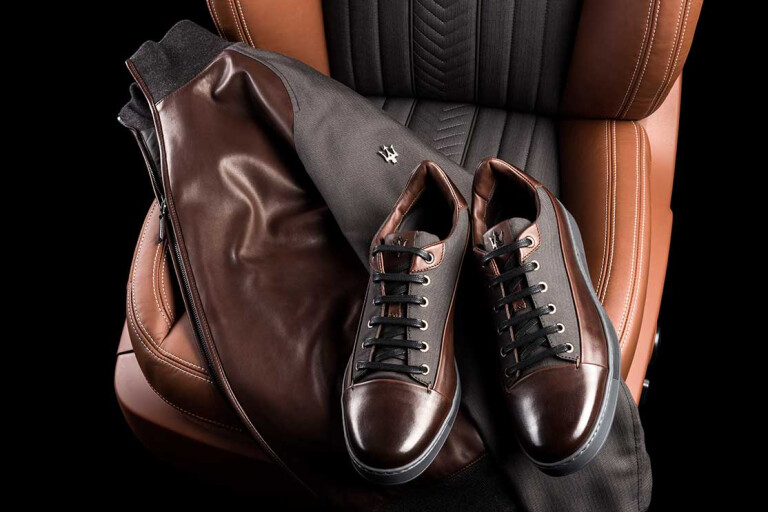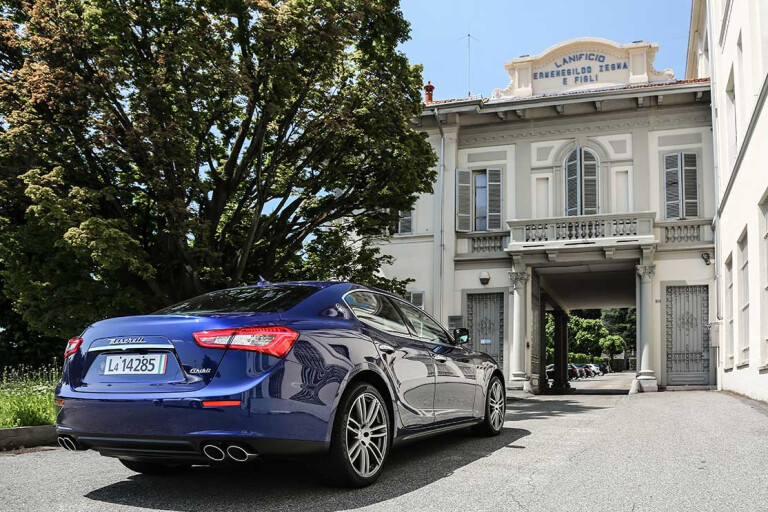
Pink reflections of the setting sun shimmered in the water behind us as we turned under an entry arch of wrought iron whirls. We’d arrived at the Grand Hotel des Iles Borromees, on the shores of Lake Maggiore in Italy, only to brake sharply on seeing the notice: “Maserati Parking Only”.
We drove through. This time, I was sitting in the Maserati for the one, and probably only, time in my life. We pull up beside the other six, parked Maserati’s; attracting star status admiration and plenty of camera-phone snapping.
Why such a shiny array of cars in this particular location? Well, I’m holding an invitation that I imagine feels a bit like winning a Melbourne Cup trifecta: first, go to Northern Italy; second, pick up a Maserati; third, drive it to the new high-tech Maserati factory in Turin. All this to celebrate what is turning out to be a very fruitful partnership between Italian super-luxury brands Maserati and menswear giant Ermenegildo Zegna.
Australians may have heard of Zegna when it was the favoured power-suit of choice of former Prime Minister Paul Keating. Or, they may know of it due to fact that these sharp, ultra-fine woolen men’s suits are made using fibres from our very own Australian Merino sheep. These are then woven in Italy in Zegna’s historic wool mill, located just up the road from our starting point.

So you might ask: What have these two seemingly very different companies got to offer one another? Well, it’s not unusual for car-manufacturers and fashion designers to cross-pollinate and give birth to luxury. In this case, Maserati has harnessed Zegna’s expertise to design and produce an uber-luxe collection of cars with interiors designed by the menswear company using Poltrona Frau leather and Zegna Mulberry Silk inserts, made at the factory.
Silk! That’s right. That delicate natural fabric favoured by underwear designers and brides. But as a car interior for a high performance vehicle better known for its precision engineering and machismo? Madness! Well that’s what head honcho Mr Wester at Maserati thought too when the idea was first mooted, but then again, he thought, why not?
It turned out to simply be a matter of technology. If you take a silk thread, tease it, twist it and subject it to all manners of hi-tech treatments, what you get is a woven silk that’s tough enough to pass Maserati’s stringent durability tests. And we were here to experience the driving comfort of this specially designed collection of interiors, which are available in the classically styled Maserati Quattroporte range and its sportier, lighter and trendier relative, the Ghibli (read the Wheels review here).
The experience started well with a perfectly frothed cappuccino and a jam-filled brioche (Italy’s version of the French croissant), followed by an early morning meander through the manicured public gardens lining the waterfront at Stresa. Peering through the filmy morning mist to the Borromean Islands, a short jet boat ride away, is more than enough to remind you why Italy has close to 50 million international visitors every year.

Leaving this picturesque lakeside town, we headed inland towards Turin via the hilly province of Biella; an area famous for its wool manufacturing, both past and present, and dotted with pretty valleys and beautiful stretches of twisting roads lined with lush foliage.
Deep within this verdant landscape we reached the historic home of the Zegna family at Trivero. The estate and its surrounds, now called Zegna Oasis, houses the Zegna museum, exhibition space and the famed fabric archives containing immaculately kept records of every pattern and colour of cloth woven in the factories below and used today as inspiration by designers around the world.
Our host, Laura Zegna, recalls days spent as a child playing with the children of the valley’s weavers. They all had deep roots in the valley. Weavers and landowners alike were striving to produce the very best quality cloth possible. Luckily for them, EG was a visionary and broke with traditions of the time by putting his name on the cloth he produced, which allowed him to build a name for himself and his company. The company is now globally recognised, when many others were overtaken by globalisation and disappeared.
EG was a man of extraordinary foresight and, back in the 1930s, he started to replant the traditional pines on the steep hills around his estate that had been denuded of trees for generations as people scavenged for much needed firewood.
A tradition that his sons and grandsons have continued, so that now almost 100 years later the road we were driving on, called Panoramica Zegna, is a visually delightful 26km route set in a 100km² reserve. It winds through the leafy mountains with spectacular glimpses to the plains below and is surrounded by meadows, fir forests and thousands of rhododendrons and hydrangeas that explode with colour in spring. And we’re seeing it all through the crystal-clear glass of a Maserati’s window.
To drive such a luxurious car in a location like this simply adds frisson to an already delightful ‘Italian’ experience. You can’t help but feel a little superior as you overtake the more sensible cars trudging to their destinations and preen as other passengers take your picture – a small glimpse into the life of living like a movie star for a day. It’s a buzz stopping in small villages for a bitter-sweet espresso or refreshing gelato and being bombarded with friendly waves, appreciative looks and admiring comments. Bella macchina (beautiful car) and a wave of the hand.
The best thing of all is that you don’t have to be driving the car to feel good and passengers still get as much enjoyment out of sitting in the silk woven side seats.

Compared to others in its class, a Maserati feels less technical and cold; its more melodramatic and extroverted. And that sound! When you put your foot down, the V8 engine in the top end Quattroporte gives out an operatic crescendo to rival any Italian diva. The plush interiors don't shout money but they feel expensive and you can’t help but feel special. This is what this partnership is all about, after all.
That expensive feel, however, means that to own one you’ll need to part with between $140,000–$200,000 for a Ghibli and around $200,000–$300,000 for a Quattroporte. But hey, what’s a few hundred thousand dollars?
Later on, in Turin, we walked through the impressive robot-filled Maserati factory watching entire chassis’ being lifted and flipped by enormous robotic arms, with others delicately gluing a windscreen. But handling the Zegna silk-covered seats, due to arrive at the end of the year, will be a job best left to human touch.
COMMENTS